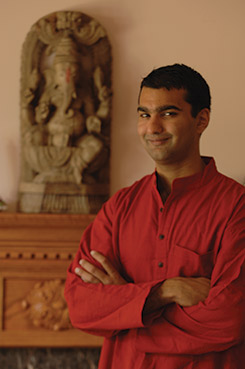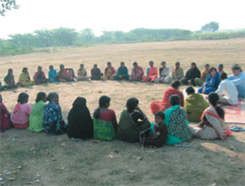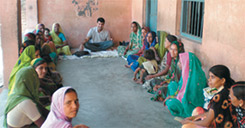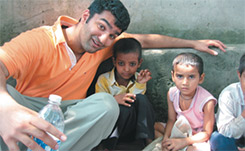Seeds of Change
An alumnus departs Wall Street to witness the microfinance revolution firsthand, and discovers his ancestral homeland in transition. By Vivek Taparia, AB’03. Photographs by Dan Dry and Vivek Taparia.
Despite the early morning haze, sunbeams visibly melted into the thatched rooftops of Chatyal, a small village 100 kilometers from the high-tech city of Hyderabad. Although I was still jet-lagged from the eleven-hour time difference between New York and India, the fresh, unpolluted air of the countryside invigorated my senses. Our jeep noisily approached the village center, where I saw small groups of women, Muslims with their darker burka garb and Hindus with their brightly colored saris and red tika markings on their foreheads, a solemnity of purpose in their eyes. As the morning sun warmed the cool ground, the women quietly seated themselves in an oval and placed their loan books by their sides. As a loan officer and I approached, the women, almost in unison, said to him “Namaste sir,” the Hindi salutation indicating reverence.
Only four months earlier, halfway around the world on Wall Street, my typical workday had begun very differently. One such morning in spring 2006, bagel in hand, I strolled to my desk on JPMorgan Chase’s fixed-income trading floor, expecting few surprises. But when I opened the Wall Street Journal Online, I got one. I immediately recognized the stipple portrait on the front page: I was staring into the face of Vikram Akula, PhD’04, a fellow student in my beginning Hindi class at the University of Chicago over six years ago. Vikram had ultimately completed his doctorate in political science from the University, writing a dissertation focusing primarily on poverty alleviation strategies.
The article about Vikram told how this relatively unknown Indian-American entrepreneur managed to borrow from some of the world’s largest banks to fund the dispersal of thousands of small loans, typically $100 or less, to village women in India to help them raise their income level above the poverty line. An Internet search further revealed that Vikram had been recognized by Time magazine in a feature on 100 “People Who Help Shape the World,” an accolade he received for leveraging technology, such as information systems and plastic debit cards, to contribute to the microfinance industry’s ongoing profitability and, more important, sustainability.
Born in India, Vikram moved to the U.S. as a young child. During his summer holidays, Vikram returned to India with his family and was jarred by the disparity in wealth between the two countries. Once while at a wedding celebration in his parents’ hometown, Hyderabad, he was particularly jolted by watching local boys scrape up rice from leftover dinner plates. After completing a graduate degree at Yale in 1995, he worked at government- and charity-financed microfinance organizations. He discovered the powerful impact a tiny loan can have on someone in poverty, but he also observed in existing microfinance models extreme waste, inefficiency, and lack of ability to scale. His experiences propelled him to eventually launch SKS Microfinance.
As an investment banker working in global credit markets at JPMorgan Chase, I was inspired by Vikram’s story. I had a vague notion of microfinance but failed to grasp how such small-time lending programs could simultaneously alleviate poverty and earn a profit. How can one successfully make loans to people so poor that they do not have any collateral to offer? How can borrowers below the poverty line ever pay back such loans? They would be likely, it seemed, to spend the proceeds of any loan to feed and clothe themselves. My curiosity was piqued and I was eager to discover firsthand exactly how Vikram had achieved such success.
At the time I was at a professional crossroads. Like many of my peers who had entered corporate investment banking programs, I was coming to the end of my contract with JPMorgan Chase. Unlike most of them, I yearned to work for a social enterprise organization in India. As an economics major in the College, I had taken many courses related to poverty alleviation. In addition, I had extensively explored the business and cultural landscape of Latin America, first studying abroad in Buenos Aires and then as a Fulbright scholar in Mexico City. As an Indian-American, I was disheartened to realize that I understood Latin culture better than my own and could speak Spanish more fluently than Hindi. Furthermore, the Indian economy was booming; I knew that working in India not only would enable me to touch base with my cultural heritage but could further my career as well.
On a calculated whim and with crossed fingers, I e-mailed Vikram reminding him of our acquaintance at Chicago and asking to join his company. Initially, SKS was skeptical that an expatriate who would likely work on a short-term basis could add value to the organization. However, after I persisted, Vikram finally agreed to take me on board. With funding and structure from the American India Foundation, a not-for-profit organization with an established program to send young American professionals to India to work in the social sector, I was off to Hyderabad, the South Indian city where SKS is headquartered.
Off to the Villages of India
One of my first tasks in Hyderabad was to visit
local villages in order to understand the grassroots
mechanisms behind microfinancing. For a full
day, I was to shadow Ravanth, an SKS loan officer,
in the nearby village of Chatyal. As we approached
the village center that morning, we were met by
the group of borrowers I described earlier. Ravanth
explained to me why they were all women: SKS
makes loans only to female borrowers because
women tend to engage in income-generating
activities and reinvest their income into the household,
while men are more likely to spend their
loans on personal consumption.
As we approached the head of the oval, we found a mat laid out for us with membership cards containing the borrower’s names and pictures. After we were seated, the borrowers, in unison, chanted a pledge in the local language, Telugu, stating that they would attend weekly meetings without fail, always pay back their loans, help out other borrowers when required, and use their loans to uplift the economic condition of their families.
Ravanth then took attendance and began collecting the women’s loan installments. One at a time, eight of the 40 women handed wads of rupees to Ravanth, who counted each note and recorded all transactions in an accounting ledger. He explained that SKS has a policy of lending to groups of five women at a time, and these eight women, the group leaders, were giving him the weekly installments for their groups. This set-up, he explained, assured a co-guarantee system: if one borrower was unable to pay one week, then the other four would cover her installment. If the group could not pay, then the center would pitch in.
This social collateral went a long way toward explaining the high repayment rates SKS experienced. The free market combined with established social norms to enable microfinance to work. Women were free to choose their own groups. Within each village, people intimately know the details of one another’s lives and would therefore naturally form their group with those they perceived to be credit-worthy. Since the borrowers in effect conducted their own credit checks among themselves, SKS was able to avoid the usually exorbitant costs of credit checks and operate profitably.
At the close of our meeting, Ravanth asked the group if there were any requests for additional loans. One woman, Umma, raised her hand and said that she wished to refinance her existing credit line in order to purchase machinery to grind spices that she could then sell in the market. She requested 5,000 rupees (approximately $100), the size of a typical loan. Ravanth asked the group if they had objections to Umma’s loan; everyone approved. With the income from selling spices, she could likely make enough money to repay her loan within a few months.
I asked Ravanth about the interest rates SKS charged, and he said they generally ranged between 21% and 28%. Seeing my astonishment, he told me that without financing from SKS, the borrowers would be forced to obtain credit from local money lenders at usurious rates, often more than 200%. He added that the borrowers’ entrepreneurial endeavors often have returns of over 100%, making SKS’s rates quite affordable. To demonstrate, he introduced me to two borrowers.
Meena was eager to tell us how microfinance changed her life. After her first 5,000-rupee ($100) loan from SKS, Meena used her savings, along with a small loan from a government scheme, to purchase a cow for 10,000 rupees ($200). That year, she paid about 2,500 rupees ($50) in interest. Then she sold six liters of the cow’s milk per day at twelve rupees a liter, earning 21,600 rupees ($430) in ten months. During the year, she then sold the calf of the cow for about 1,000 rupees ($20). Her total revenues from the cow that year of 22,600 rupees ($450), against total costs of around half that amount, provided her household with an incremental $200 per year. This new income stream enabled Meena to pay for her son’s education rather than keeping him home to work.
Next, Ravanth took me to see Rama. With a one-year loan of 5,000 rupees ($100), she had leased two flowering mango trees in order to sell their fruit. Although she paid only 1,200 rupees ($24) in interest, Rama made 12,000 rupees ($240) in income during mango season. This extra income allowed her to afford medication for the typhoid her daughter had recently contracted. Microfinance had afforded Meena and Rama access to health care and education, significantly improving the livelihood and future prospects of their families.
A Country of Brilliant Minds
After familiarizing myself with their work in the
field, I was assigned to assist SKS’s finance department
at their headquarters in Hyderabad. I became
heavily involved in helping the company raise private
equity and venture capital funding in order to
foster its continued growth. SKS had been expanding
at a dizzying pace, growing from around
200,000 to more than 500,000 clients in 2006.
During this time, the company also entered six
new states in India, opening a new branch almost
every day and employing over 1,500 people.
One of my primary tasks at SKS was to create operational and financial models to forecast the company’s growth and profitability—no easy task for a rapidly growing organization with funding needs that change on a daily basis. I elicited the help of two colleagues, Ram and Mukesh, both freshly minted 23-year-old recruits from rural Indian management schools. In a matter of a few weeks, they were able to develop a sound understanding of our company’s operations and incorporate this knowledge into robust models that captured the complexity of the organization in intricate detail. Their mathematical aptitude, strategic understanding, and acumen at developing operational algorithms were truly amazing.
Working alongside such brilliant young colleagues gave me added insight into India’s new economy and the country’s growth story. India has such burgeoning numbers of young people that the country is expected to be one of the most important sources of workers for global labor markets in the coming decades. Most of the employees of SKS are quite young, with almost no one over 40. I began to see why companies continue to outsource increasingly professional jobs to India. Outsourcing did not stop with Citibank moving their call centers to India. Technology companies like Microsoft have outsourced software programming, and pharmaceutical companies such as Merck have outsourced research and development. My experience with Ram, Mukesh, and others made it increasingly clear to me just how much multinational companies are saving by having Indian operations. Ram and Mukesh were just as smart, if not more quantitatively versatile, than any Ivy League-educated employee on a derivatives desk on Wall Street. However, they made about 20 times less than their Wall Street counterparts. With underlying economics like these, the outsourcing trend is not going to end anytime soon.
Investing in Rural Markets
When the pioneer of microfinance and founder
of the Grameen Bank, Mohammad Yunus, won
the Nobel Peace Prize in October 2006, the world
was watching—especially the global investment
community. Working closely with commercial
investors wishing to fund microfinance organizations,
I understood the keen interest in this area.
While many of these investors acknowledge the
social benefits of microfinance, they are primarily
motivated by the lucrative opportunity it offers.
The market for microfinance is enormous and
largely unpenetrated given the sheer number of
individuals below the poverty line. And established
microfinance institutions, unlike larger
corporations, have existing relationships with the
rural poor.
In general, the rural poor in India have typically paid a “poverty premium” for basic consumer goods, including food, soups, and shampoos, because such products often change hands between multiple intermediary brokers before reaching rural markets. As the rural poor break poverty traps with microfinance funding, they will seek access to more consumer goods through their enhanced buying power. Microfinance institutions can then leverage their existing footprint and borrower network in rural areas and serve as a distribution channel for these goods.
While there are many players in the microfinance sphere in India, the market is still largely untapped, leaving room for multiple competitors. Ten years ago, 400 microfinance institutions boasted 200,000 customers. Today there are 1,000 institutions that, together with 300 commercial banks, lend to 17.5 million people. With 260 million people living on less than $1 a day, however, the market is largely underserved. Microfinance organizations still have incredible growth opportunities.
A Land of Dichotomies
While I was showing a group of investors one of
our villages, it occurred to me that India really is
many countries within one country. In the village,
I was surrounded by women below the poverty
line living in an area with minimal social infrastructure.
However, on the short drive back into
the city, we passed the high-tech part of Hyderabad,
also known as “Cyberabad.” One would be
hard-pressed to tell this area apart from California’s
Silicon Valley. The newly erected buildings
created a mini-skyline of the glass and steel homes
of corporate powerhouses like Microsoft, Oracle,
Google, and Deloitte. Although it was midnight,
many young employees were just leaving their
offices after a day’s work while others entered to
start a new shift.
After passing Cyberabad, we also drove through the Charminar, the old city portion of Hyderabad, which houses a prominent Muslim monument with four minarets similar to those of the Taj Mahal. These have stood tall for over 400 years and were constructed by Muslim nizams who ruled the city over the centuries. In front of the Charminar sits an aging Hindu temple, its peaceful coexistence with its primarily Muslim surroundings defying the religious factionalism periodically erupting across the land.
Although the majority of the country’s citizens are Hindu, India has one of the largest Muslim populations in the world, representing about 15% of the country’s billion-plus population. Recently a bomb blast exploded in a mosque in the Charminar neighborhood. While many feared that riots would surface, only peace and collective commiseration ensued, testifying to the ability of India’s diverse religious groups to live together harmoniously. I believe this especially holds true in the villages, where I often witnessed Hindu and Muslim women borrowing in the same microfinance circles and co-guaranteeing one another’s loans.
My experience in India gave me insight into the country’s deep complexities. Most especially, however, I have gained firsthand exposure to one of the most astonishing economic growth stories of this century. Sharing in the vision of social entrepreneurs like Vikram Akula, I dare to hope that the destitute villagers and slum dwellers can ultimately rise above the poverty line and also engage in India’s economic boom.



